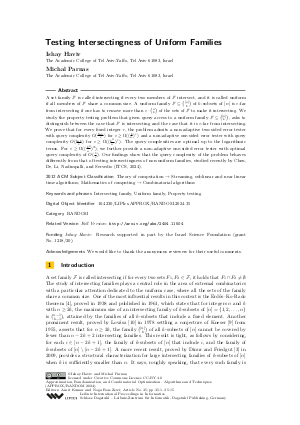Testing Intersectingness of Uniform Families
Authors Ishay Haviv, Michal Parnas
-
Part of:
Volume:
Approximation, Randomization, and Combinatorial Optimization. Algorithms and Techniques (APPROX/RANDOM 2024)
Part of: Series: Leibniz International Proceedings in Informatics (LIPIcs)
Part of: Conference: International Conference on Approximation Algorithms for Combinatorial Optimization Problems (APPROX)
Part of: Conference: International Conference on Randomization and Computation (RANDOM) - License:
 Creative Commons Attribution 4.0 International license
Creative Commons Attribution 4.0 International license
- Publication Date: 2024-09-16
File

PDF
LIPIcs.APPROX-RANDOM.2024.35.pdf
- Filesize: 0.67 MB
- 15 pages
Document Identifiers
Related Versions
- Full Version http://arxiv.org/abs/2404.11504
Subject Classification
ACM Subject Classification
- Theory of computation → Streaming, sublinear and near linear time algorithms
- Mathematics of computing → Combinatorial algorithms
Keywords
- Intersecting family
- Uniform family
- Property testing
Metrics
- Access Statistics
-
Total Accesses (updated on a weekly basis)
0PDF Downloads0Metadata Views
Abstract
A set family F is called intersecting if every two members of F intersect, and it is called uniform if all members of F share a common size. A uniform family F ⊆ binom([n],k) of k-subsets of [n] is ε-far from intersecting if one has to remove more than ε ⋅ binom(n,k) of the sets of F to make it intersecting. We study the property testing problem that given query access to a uniform family F ⊆ binom([n],k), asks to distinguish between the case that F is intersecting and the case that it is ε-far from intersecting. We prove that for every fixed integer r, the problem admits a non-adaptive two-sided error tester with query complexity O((ln n)/ε) for ε ≥ Ω((k/n)^r) and a non-adaptive one-sided error tester with query complexity O((ln k)/ε) for ε ≥ Ω((k²/n)^r). The query complexities are optimal up to the logarithmic terms. For ε ≥ Ω((k²/n)²), we further provide a non-adaptive one-sided error tester with optimal query complexity of O(1/ε). Our findings show that the query complexity of the problem behaves differently from that of testing intersectingness of non-uniform families, studied recently by Chen, De, Li, Nadimpalli, and Servedio (ITCS, 2024).
Cite As Get BibTex
Ishay Haviv and Michal Parnas. Testing Intersectingness of Uniform Families. In Approximation, Randomization, and Combinatorial Optimization. Algorithms and Techniques (APPROX/RANDOM 2024). Leibniz International Proceedings in Informatics (LIPIcs), Volume 317, pp. 35:1-35:15, Schloss Dagstuhl – Leibniz-Zentrum für Informatik (2024)
https://doi.org/10.4230/LIPIcs.APPROX/RANDOM.2024.35
BibTex
@InProceedings{haviv_et_al:LIPIcs.APPROX/RANDOM.2024.35,
author = {Haviv, Ishay and Parnas, Michal},
title = {{Testing Intersectingness of Uniform Families}},
booktitle = {Approximation, Randomization, and Combinatorial Optimization. Algorithms and Techniques (APPROX/RANDOM 2024)},
pages = {35:1--35:15},
series = {Leibniz International Proceedings in Informatics (LIPIcs)},
ISBN = {978-3-95977-348-5},
ISSN = {1868-8969},
year = {2024},
volume = {317},
editor = {Kumar, Amit and Ron-Zewi, Noga},
publisher = {Schloss Dagstuhl -- Leibniz-Zentrum f{\"u}r Informatik},
address = {Dagstuhl, Germany},
URL = {https://drops.dagstuhl.de/entities/document/10.4230/LIPIcs.APPROX/RANDOM.2024.35},
URN = {urn:nbn:de:0030-drops-210288},
doi = {10.4230/LIPIcs.APPROX/RANDOM.2024.35},
annote = {Keywords: Intersecting family, Uniform family, Property testing}
}
Author Details
Funding
- Haviv, Ishay: Research supported in part by the Israel Science Foundation (grant No. 1218/20).
Acknowledgements
We would like to thank the anonymous reviewers for their useful comments.
References
- Hou Tin Chau, David Ellis, Ehud Friedgut, and Noam Lifshitz. On the maximum degree of induced subgraphs of the Kneser graph. arXiv, abs/2312.06370, 2023. URL: https://arxiv.org/abs/2312.06370.
-
Xi Chen, Anindya De, Yuhao Li, Shivam Nadimpalli, and Rocco A. Servedio. Testing intersecting and union-closed families. In Proc. of the 15th Innovations in Theoretical Computer Science Conference (ITCS'24), pages 33:1-33:23, 2024.

-
Irit Dinur and Ehud Friedgut. Intersecting families are essentially contained in juntas. Comb. Probab. Comput., 18(1-2):107-122, 2009.

-
Paul Erdős, Chao Ko, and Richard Rado. Intersection theorems for systems of finite sets. Quart. J. Math., 12(1):313-320, 1961.

- Eldar Fischer. A basic lower bound for property testing. arXiv, abs/2403.04999, 2024. URL: https://arxiv.org/abs/2403.04999.
- Peter Frankl and Andrey Kupavskii. Maximal degrees in subgraphs of Kneser graphs. arXiv, abs/2004.08718, 2020. URL: https://arxiv.org/abs/2004.08718.
-
Ehud Friedgut and Oded Regev. Kneser graphs are like Swiss cheese. Discrete Analysis, 2:1-18, 2018.

-
Oded Goldreich. Introduction to Property Testing. Cambridge University Press, 2017.

-
Martin Kneser. Aufgabe 360. Jahresbericht der Deutschen Mathematiker-Vereinigung, 58(2):27, 1955.

-
László Lovász. Kneser’s conjecture, chromatic number, and homotopy. J. Comb. Theory, Ser. A, 25(3):319-324, 1978.

-
Colin McDiarmid. Concentration. In Probabilistic methods for algorithmic discrete mathematics, volume 16 of Algorithms Combin., pages 195-248. Springer, Berlin, 1998.

-
Michal Parnas, Dana Ron, and Ronitt Rubinfeld. Tolerant property testing and distance approximation. J. Comput. Syst. Sci., 72(6):1012-1042, 2006.

-
Roei Tell. A note on tolerant testing with one-sided error. In Computational Complexity and Property Testing - On the Interplay Between Randomness and Computation, pages 173-177. Springer, 2020.

